What Is Pomegranate Molasses And How Do You Use It?
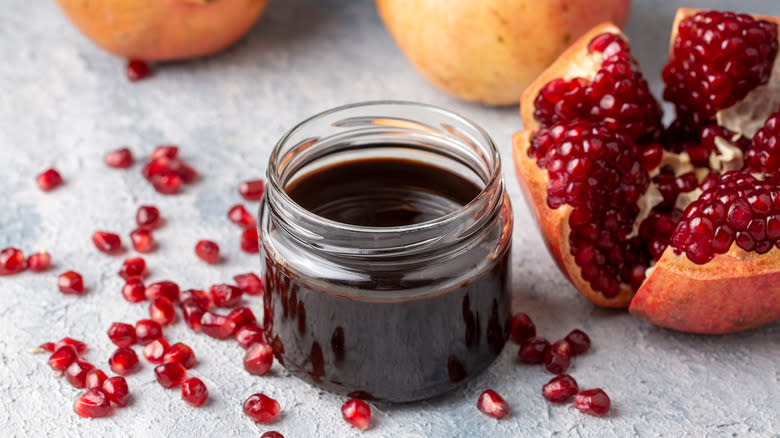
We may receive a commission on purchases made from links.
Pomegranates are a distinctive, ruby red fruit made up of juicy arils (the casing around the seeds) that crop up in everything from salads to cocktails. Their history extends back so far that some believe it was a pomegranate that Eve ate in the Garden of Eden instead of an apple. It appears in both the Quran and the Bible, while in Greek Mythology, the goddess Persephone is tricked into becoming the Queen of the Underworld when she eats pomegranate seeds offered to her by Hades. In Buddhism, the pomegranate is one of the three blessed fruits.
Across the centuries, the fruit has maintained an integral presence in Middle Eastern, North African, and Mediterranean cuisines in the form of molasses, the sweet-sour syrup made by simmering pomegranate juice into a thick syrup. Despite being mainly associated with Middle Eastern, Mediterranean, and North African cuisines, pomegranate molasses is growing in popularity in North America with the help of several high-profile proponents. Food Network star Bobby Flay touts it as one of his favorite ingredients and secret weapon in salad dressings due to its ability to balance salt and sweetness. Similarly, former "Top Chef" host Padma Lakshmi told Mashed in 2022 that she loves the sticky sweetness of pomegranate molasses, especially when it's drizzled over cheese. Given these glowing endorsements, it's high time we dive into the history and culinary applications of this delicious ingredient to discover what makes it so special and how we can use it to elevate our culinary pursuits.
Read more: 7 Nuts You Should Be Eating And 7 You Shouldn't
It Holds Particular Significance In Middle Eastern Culture
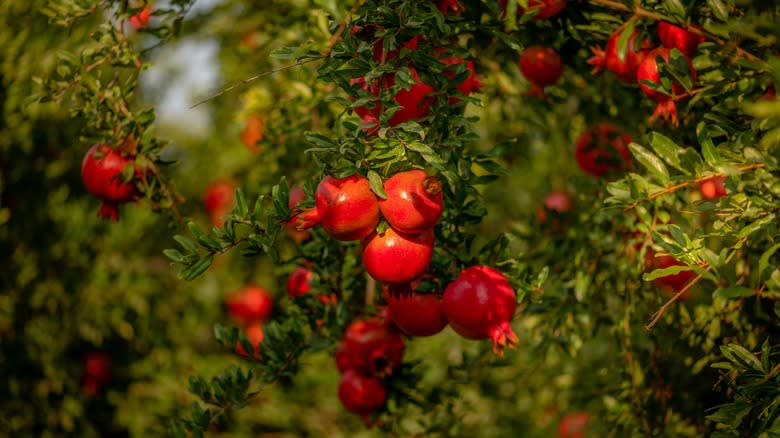
The pomegranate appears in the sacred texts of many faiths and ancient mythologies, but nowhere is it as prominent as it is in Middle Eastern culture. It is mentioned several times in the Quran, including in a verse that promises the fruit will be found in Paradise. There is also a saying attributed to the Prophet Muhammad that eating pomegranates illuminates the soul for forty days. In Islam as well as Christianity, Judaism, and Buddhism, the fruit symbolizes fertility. A time-honored tradition in Bedouin and Middle Eastern weddings involves the groom splitting open a pomegranate when he and his bride cross the threshold of their home, with the seeds in the fruit representing the abundance of children that the couple will produce.
In Middle Eastern cuisine, pomegranate molasses has overtaken fresh pomegranates in importance, which is reflected in the specific translations of it across various languages and countries. In Arabic, it is dibs rumman or rub al-rumman. In Turkish, it is nar ekşisi. And in Georgia and Azerbaijan, it is narsharab. The thick, tangy syrup is used in a wide range of dishes and is a mainstay in Middle Eastern grocery stores around the world.
It Has A Sweet And Sour Flavor
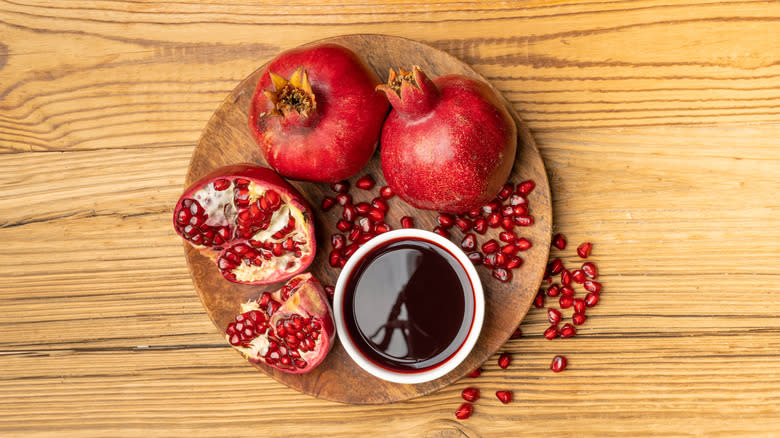
The most important thing to know about pomegranate molasses is its flavor. If you've had pomegranate juice, you'll have a good idea of what to expect. Pomegranates are tangy and only slightly sweet, with an astringent mouthfeel. Because the molasses is a reduction of the juice, it is even more tart, making it a prized addition to savory concoctions like salad dressing. In some recipes and store-bought versions of the syrup add sugar or lemon juice to dial up the sweetness or tanginess, so it's worth checking the label if you have a particular flavor balance in mind.
The interplay between sweet and sour is deepened further by a slight bitterness, preventing the molasses from being overly sugary, even when more sugar is added. Above all, pomegranate syrup is unmistakably fruity and lightly floral, a fact that may seem obvious given its main ingredient, but which distinguishes it from other syrups like sugarcane molasses and even date syrup.
It's Tough To Categorize
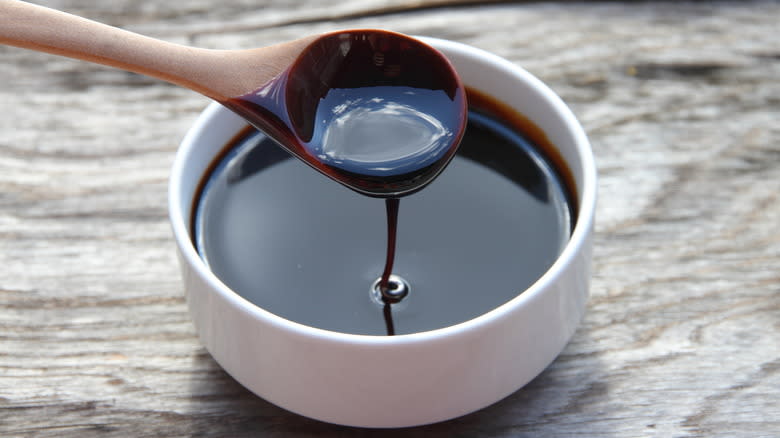
Despite being called molasses (or syrup, as it is often labeled), pomegranate molasses is not a good substitute for sugarcane molasses or fruit-based syrups. Due to its acidity, it is actually more of a condiment than a sweetener, and if you were to use it interchangeably with honey or maple syrup, for example, you would probably end up with unpleasantly tangy results. A more appropriate comparison to pomegranate molasses is balsamic vinegar, another acidic condiment that has a rich sweetness under its sharpness.
The amount of sugar in pomegranate molasses varies depending on the product, but when made with pure pomegranate juice, there are only about seven grams per tablespoon. In comparison, pure date syrup made without added sugar has about 14 grams, and molasses, despite its trademark bitterness, has 15. If you're making a recipe that calls for pomegranate molasses and you need a quick substitute, you're better off using balsamic vinegar than sugary syrups, though if it's a sweet recipe, you might prefer to improvise with sugar syrup and a squeeze of lemon Ultimately, however, the reason pomegranate syrup is so prized is because there is no perfect substitute for it. Its mixture of fruity, tangy, and sweet flavors is tough to come by in any other product.
You Can Make It At Home
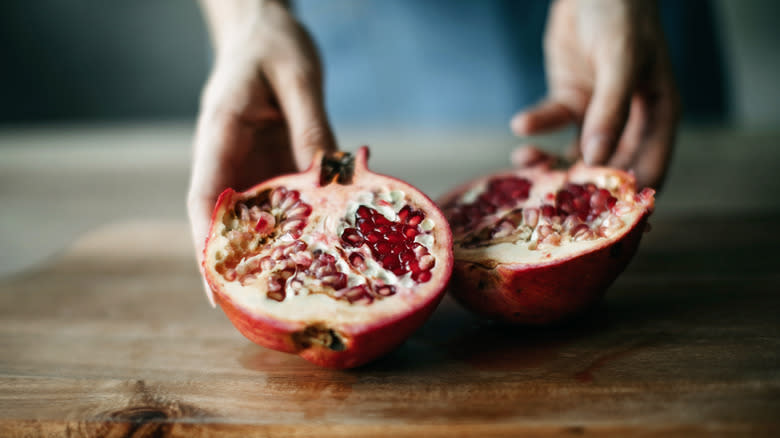
These days, you can find pomegranate molasses in many stores across the country, especially Middle Eastern and health food stores. It's also widely available online. However, it is also easy to make at home, allowing you to control its sweetness and consistency. You can either make it with pomegranate juice or from whole pomegranates. The first option is the easiest, since you won't have to worry about extracting the arils from the fleshy skin, but pomegranate juice can also be expensive, which might make the effort of making it from scratch worth it.
To make pomegranate syrup with whole pomegranates, you'll need to extricate the arils from the flesh. (This handy trick will make the dreaded process surprisingly quick). Then blend the seeds in a food processor or blender and strain them to separate the clear juice from the pulp. Transfer the liquid to a saucepan and simmer until it reaches the desired consistency, remembering that it will thicken as it cools.
When making molasses from whole pomegranates, keep in mind that one large pomegranate will make about ½ cup of juice, which in turn will make less than one-tenth of a cup of syrup. If you want to get more than a tablespoon out of your hard work, you should plan to use at least four pomegranates.
Store-Bought Pomegranate Molasses Varies Greatly
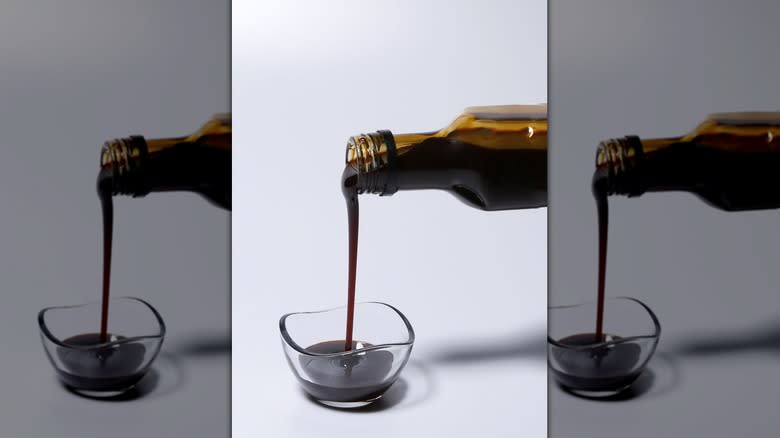
If you aren't making your own pomegranate molasses, there are a few things to look out for when you head to the store. The first thing to note is the ingredients. Many products are marketed as "100% natural," but you should still check the fine print to make sure there are no added sugars. If you're planning to use the molasses in a cocktail or a sweet dish, extra sugar probably isn't a concern, but if you're making salad dressing or other savory recipes, a product that is diluted with sugar will not provide the tanginess you're looking for.
Based on several products on the market that are labeled as pomegranate molasses or syrup, you might end up with a condiment that has anywhere from seven grams of sugar per tablespoon to 14. There are even some products that list sugar as the first ingredient, indicating that it is even more of a defining feature in the recipe than pomegranate itself. For pancakes and yogurt, pomegranate-flavored sugar syrup might be just the thing, but for making classic Middle Eastern dishes or tangy recipes, you'll need something a little more potent.
It Can Be Used In Sweet And Savory Recipes
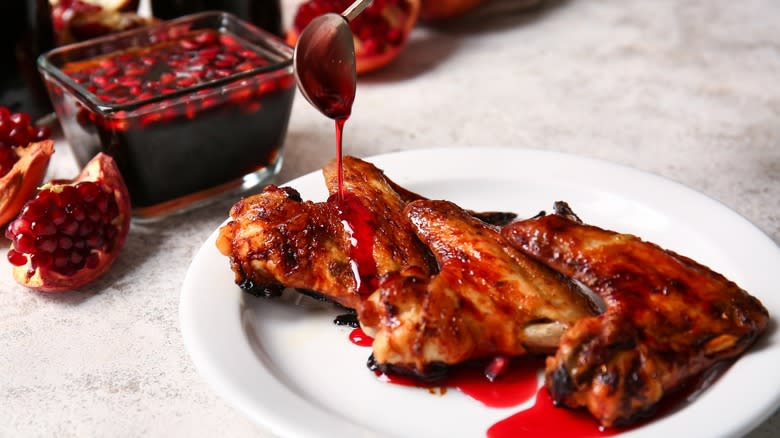
Pomegranate molasses punches above its weight in both flavor and versatility. Unlike balsamic vinegar, it can easily slot into a sweet recipe without seeming experimental, and it is more pleasantly sour than cherries when it's incorporated into savory foods. Our recipe for Pomegranate Chicken Salad is an excellent example of its range. Combined with olive oil, mustard, salt, and pepper, it doesn't produce the cloying sweetness of raspberry vinaigrettes, nor the intense acidity of a typical balsamic vinaigrette. It arrives somewhere in the middle, capturing the essence of both without falling heavily on either end of the sweet-sour spectrum. As a result, it makes the perfect complement to arugula and feta, both of which already have their fair share of acidity and bitterness.
On the other side of the culinary scale are sweet, fruity beverages. In our recipe for non-alcoholic Christmas punch, for example, you could easily swap the two cups of pomegranate juice for ⅓ cup of pomegranate syrup and two cups of water. In this recipe, which also contains cranberry juice, sugar, and ginger ale, it's the sweetness of the pomegranate that shines through, undercut to perfection with its own tanginess.
There are many ways to incorporate pomegranate molasses into your recipes even when it doesn't appear in the ingredients list, such as turning it into a single-ingredient glaze for meat or drizzling it over a sugary dessert to add a tangy dimension to the sweetness.
It Plays A Key Role In Several Classic Middle Eastern Dishes
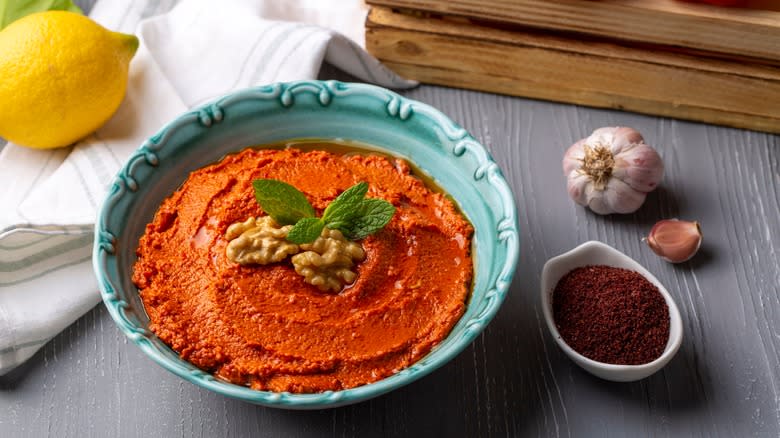
There is plenty of room to experiment with pomegranate molasses, but there are a plethora of recipes that have been perfected by generation after generation of cooks that provide an excellent place to start. One of the most beloved is muhammara, a Syrian dip named after the Arabic word for "reddened." It's made with roasted peppers and walnuts, and gains its signature tang from pomegranate molasses and a hint of lemon juice.
Another classic recipe that features the powerful ingredient is fesenjān, a rich, dense, flavor-packed Iranian stew made with chicken. In this recipe, the molasses plays an integral role in giving the dish its sweet and sour flavor, while ground walnuts provide its rich, almost paste-like broth. Then there's fattoush salad, a Lebanese staple made of lettuce, tomatoes, onions, peppers, and other fresh vegetables along with toasted pita. These ingredients are tossed in a mouthwatering dressing comprised of olive oil, pomegranate molasses, lemon juice, and an intricate combination of herbs and spices including sumac, allspice, and mint.
As these recipes demonstrate, pomegranate molasses isn't just reserved for one type of recipe in Middle Eastern cuisine. It's an integral ingredient across the spectrum of dishes, from dips to meaty entrees to refreshing salads, and these three recipes barely scratch the surface.
It's More Practical And Versatile Than Pomegranates
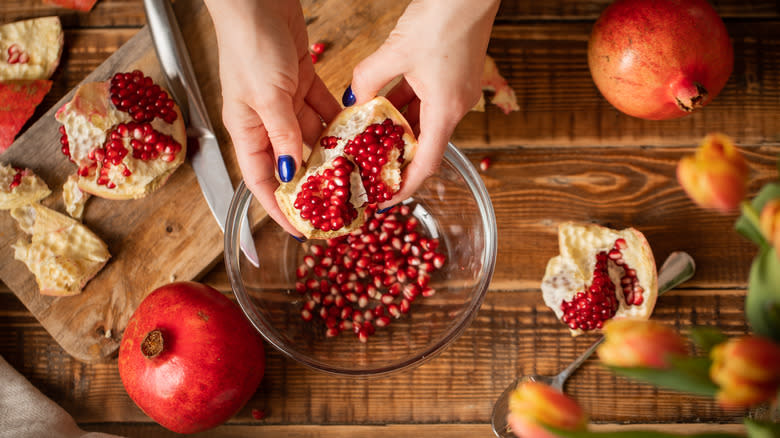
Although most North Americans are probably more accustomed to using pomegranate arils in their cooking, pomegranate molasses is actually easier to use and more versatile. There are countless pieces of advice on the internet about the best way to get the stubborn arils out of a whole pomegranate, which is a pretty good indication of how tricky these juicy gems are to extricate. Maybe you prefer to use the bowl of water option or the shaking option. Maybe you just save up every shred of patience and do it one at a time. Whatever the method, you're likely to feel irritated by the end of it.
Even when you do manage to separate the arils, you need to decide how to use them. Sure, you could sprinkle them on top of a recipe, but isn't that more decorative than anything else? If you want the full force of a pomegranate's flavor, it needs to be a baked-in part of the recipe, not just a deliciously crunchy garnish. Pomegranate molasses is the solution. You can still use the arils as a visual and textural embellishment, but you don't have to rely on them for flavor. Molasses is a particularly helpful option when you don't want any crunchiness or pockets of juice in your recipe. Simply grab a bottle of the rich, tangy syrup -- you'll have all the pomegranate flavor you could wish for, and none of the frustration.
Its Appearance Depends On Temperature
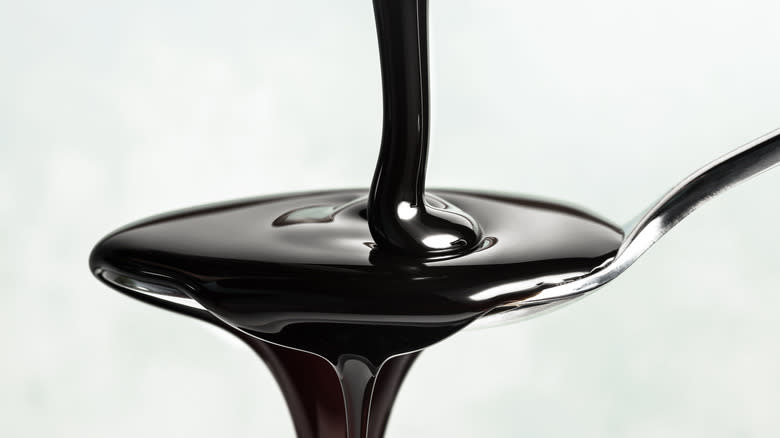
When you browse the different options for pomegranate molasses, you may discover they vary in color. Some products are the deep, brown-black color of sugarcane molasses, while others are a rich, blood red. Both these options might be made of 100% pomegranate and have the same syrupy consistency, so how can they look so different? The answer has to do with chemistry.
The pigment that gives pomegranates their luscious ruby hue is called anthocyanin, and despite its intense appearance, it is, at heart, extremely delicate. Depending on the pH of its environment, it will be red (indicating a highly acidic solution), blue (a neutral pH), or green (an alkaline environment, such as water with baking soda). It is also very sensitive to heat. When it's subjected to a high temperature over a long period of time, it dies off. This poses a complication for those making pomegranate molasses. You need the juice to reduce long enough to result in a syrupy consistency, but you don't want to cook it long enough or hot enough to kill the anthocyanin. For best results, you'll need a thermometer. Keeping the simmering liquid no higher than 200 degrees Fahrenheit will prevent the delicate pigment from degrading into a dark brown hue, but will still reduce the juice to the desired consistency after about an hour.
It's Full Of Antioxidants
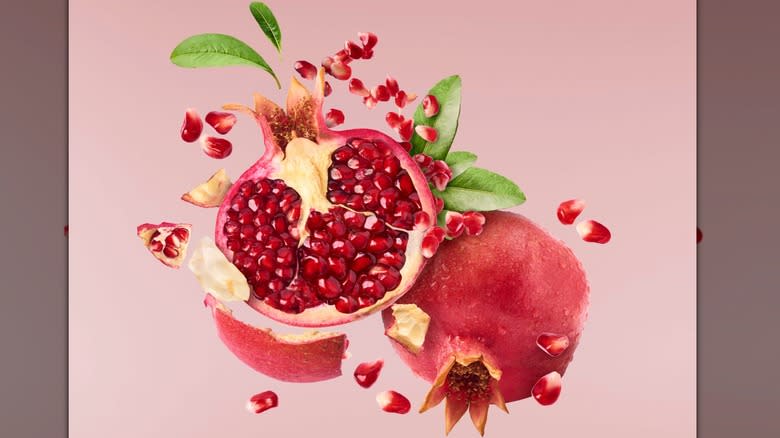
Polyphenols are powerful compounds that fight various forms of inflammation and oxidative stress, and pomegranates are full of them. The antioxidants are found in the seeds, skin, and juice of the fruit, and are even responsible for its ruby-red color. Extensive research indicates that polyphenols help slow and reduce the risk of cancers, cardiovascular disease, and neurodegenerative diseases like Alzheimer's. They may even help fight aging. They do all of this by neutralizing free radicals, molecules that are the byproducts of everything from x-rays, smoking, air pollution, chemicals, and simply living our daily lives. No matter how hard you try to prevent free radicals from entering your body, there is no way to escape them entirely, which is why food manufacturers are so eager to tout the antioxidant qualities of their products.
There are many foods and beverages that contain high levels of antioxidants, including coffee, dark chocolate, and various fruits. In a study published in Nutrition Journal tracking the number of antioxidants in samples of 3100 substances, however, researchers found that pomegranate juice had more than all the others they tested except for coffee, red wine, and espresso. Given the side effects of coffee and alcohol, pomegranate molasses can be considered a very good way to attain antioxidants in beverage or condiment form; and though pomegranate seeds may pose a choking risk to young children, pomegranate molasses is an excellent way to get kids to eat this nutritious fruit.
It's Surprisingly Affordable
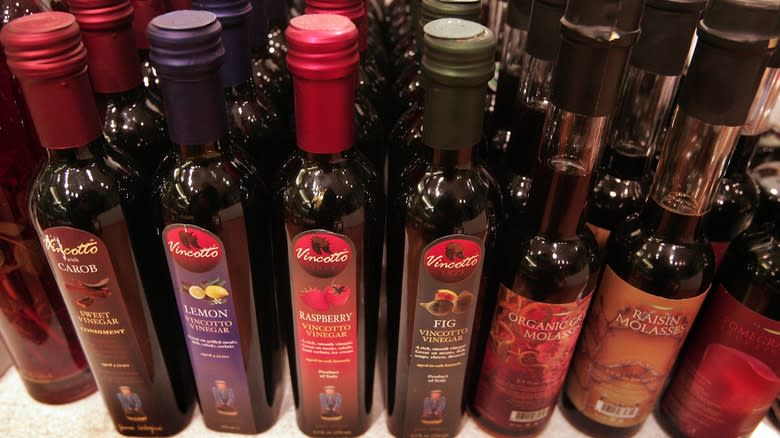
If you've ever purchased pomegranate juice, you might have noticed that it's really expensive. This isn't particularly surprising given how challenging it is to extract the arils from the fruit, but it does mean that most of us opt for cranberry or apple juice instead. You might assume, therefore, that pomegranate molasses, which is a reduction of the juice, would be even pricier, but that just isn't the case when you take its potency into account.
At the time of this writing, pomegranate juice can cost anywhere from $0.25 per fluid ounce for POM Wonderful Pomegranate Juice to $0.44 per fluid ounce for Lakewood Organic Pure Pomegranate Juice. Considering that pomegranate molasses is about six times as strong as juice, you'd think that the price would follow the same logic, falling somewhere between $1.50 per fluid ounce and $2.64. However, depending on which brand you purchase, pomegranate molasses costs about $1.20 per fluid ounce, a significant decrease compared to juice.
On the other hand, pomegranate molasses is less affordable when compared to other syrups. Date syrup, for example, ranges from about $0.75 per fluid ounce to $1.08, while pure maple syrup, one of the pricier sweeteners on the market, might only cost you around $0.90 per fluid ounce at the time of writing. Then there's balsamic vinegar, which can cost more than $300 per fluid ounce.
It Needs To Be Stored Correctly
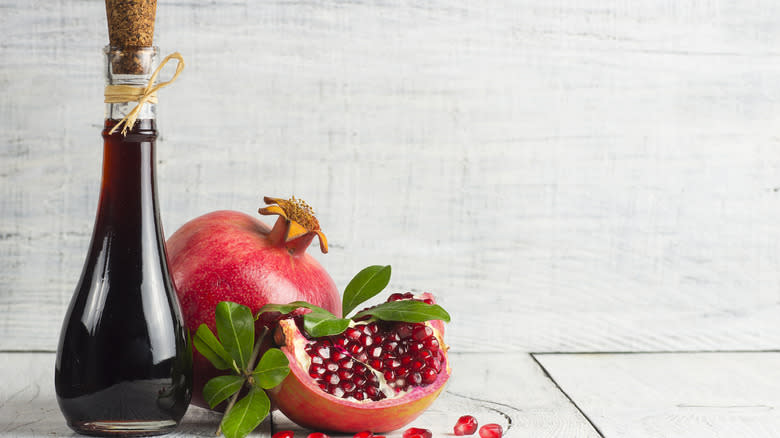
Sweet condiments are rarely as perishable as meats, veggies, dairy, or pretty much any other item on your grocery list that doesn't go in the pantry. However, some sweeteners that contain high amounts of water, such as maple syrup, should be kept in the fridge to avoid mold. The water content in your pomegranate molasses will depend on the product or recipe, but it's best to be safe and keep it chilled like maple syrup. This will preserve it for months, if not years. Just make sure to take it out of the fridge for at least 10 minutes before using it to allow it to soften.
One concern when storing pomegranate syrup that doesn't apply to most other sweet condiments is its acidity. If kept in a container made of a reactive material such as aluminum, cast iron, or copper, it will take on a metallic flavor and even change color. Pomegranate juice is so acidic that you should even make sure you're not using a container with a metal lid such as a Mason jar. You can usually get away with pairing reactive metal and acidic ingredients when cooking them, but when it comes to storing acidic food for weeks and months, the results will be unappetizing and potentially harmful.
Read the original article on Mashed.


